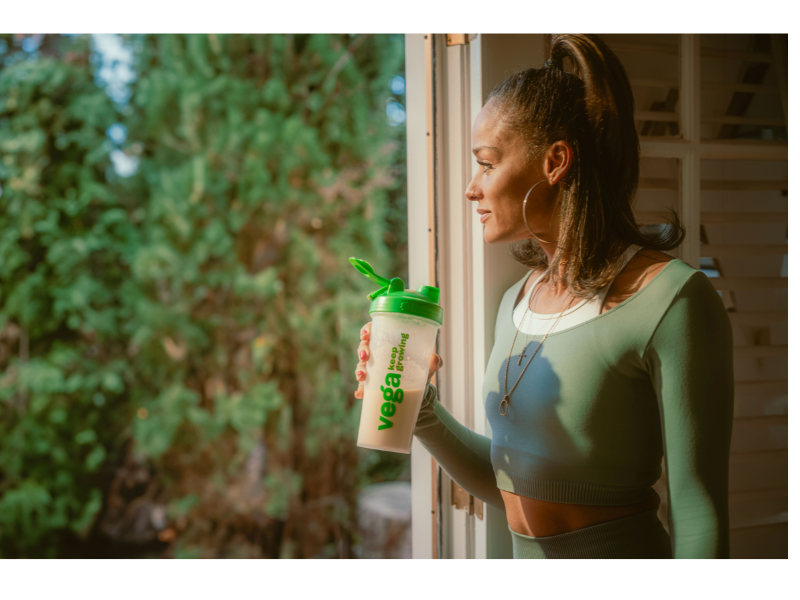Nicole Osinga: Dietitian's Exercise Do's and Don'ts

As a Dietitian that often designs nutrition programs for athletes, I see many mistakes that athletes make with their nutrition, which will in turn not only hinder performance but recovery as well!
Pre-Workout
Do: Have Caffeine + Water Before a Workout
Caffeine has been shown to enhance exercise performance (100-200 mg/time, which is a small coffee). Hydrate with about 500-700 ml of fluid within an hour of your exercise. If you’re not in the mood for coffee, the Vega Sport Energizer is a perfect pre-workout energizer, as it contains 100 mg of caffeine to help fuel your workout.
Don’t: Have Excess High FODMAP Foods Pre-Exercise
FODMAPS are types of carbohydrates that are easily fermented and can cause gastrointestinal distress when eaten in excess. Common FODMAP-containing foods are apples, onions, and cruciferous veggies like broccoli. You don’t want GI distress during a workout!
Do: Have Slow-Burning Carbohydrates Before a Workout:
Consuming slow-burning carbohydrates like oats before a workout helps to deliver fuel to your muscles. Pair those slow-burning carbs with a bit of protein, like a plant-based protein powder (Vega Sport Protein), for sustained energy.
Don’t: Workout on a Completely Empty Stomach:
If you’re doing some light yoga or going for a half-hour work, you are likely okay to do these on an empty stomach. However, for moderate to higher intensity exercise, fasting before exercise usually leads to a sub-par workout, light-headedness, or early fatigue.
During Workout
Don’t Forget Intra-Workout Fuel + Electrolyte
If you are doing an intense workout or working out for longer than 45 minutes, you may want to bring fuel and electrolytes with you, in addition to water. The Vega Sport Plant-Based Hydration contains sodium, potassium, and magnesium to help replace those minerals that are lost during perspiration.

Do: Increase Salt During Prolonged Exercise
For repeated bouts of prolonged exercise, it is helpful to increase the salt intake during meals to help the body maintain fluid balance. You can make your own sports drink by combining 2 cups of water, juice of 1/2 lemon, 1/8-1/4 tsp salt, and 1 tsp sweetener.
Post-Workout
Do: Eat Within 30 Mins to 1 Hour After Your Session:
Eating right after exercise can help you rebuild your muscle proteins and glycogen stores, enhancing recovery.
Don’t Skip Carbs After a Workout:
A common mistake I see is having just protein after a workout. Yes, your muscles need protein for repair, but you also need to replenish the glycogen that you’ve burnt during the workout!
Do: Have Adequate Protein (Including BCAAS) Post-Workout
Intense or prolonged activity causes an increase in muscle protein breakdown. This is followed by an increase in muscle protein synthesis over over the next 24 hours. Ideally, protein should be consumed within 30 minutes of finishing a workout - and what more convenient way to consume protein than in a shake? My go-to post-workout protein boost is Vega Sport Protein, which contains 30g of protein, including 5 g of BCAAS (Branch Chain Amino Acids). BCAA’s are very effective in rebuilding and repairing muscle post-workout. It’s one of the best plant-based protein powders out there.
Don’t: Have Alcohol Post-Workout
Alcohol is a big NO after workouts. It might sound fun to grab a celebratory drink after crushing it at the gym, but alcohol slows down the repair process of exercise-induced muscle damage by inhibiting the production of certain hormones that are used to help, like testosterone. Alcohol is also a diuretic, so when you are already dehydrated after a workout, this will only delay the recovery process more.
Do: Consume Potassium & Magnesium-Rich Foods
Lack of potassium and magnesium can cause cramps or muscle spasms. After an intense workout, you need potassium and magnesium to avoid leg cramps. Potassium and magnesium are electrolytes that are responsible to lower pH levels in your body, and they influence the amount of water in your body. Potassium and magnesium rich foods include bananas, nuts, beans and sweet potatoes. Vega Sports Recovery is also a great source of potassium and magnesium, to compliment your potassium and magnesium-rich foods.

Don’t: Exercise to ‘Burn Off’ Food
Food is more than fuel, and movement is more than burning calories. When it comes to considering sports nutrition needs, relying solely on calorie and nutrient calculations may not be enough. Timing, ease of digestion, and taste are just some of the factors that still need to be considered too.
Related Articles
-
 Read article
Read articleHow Much Creatine Should You Take for Optimal Performance and Recovery?
Creatine is known to be an effective supplement for improving strength, endurance, and muscle recovery. Whether...
-
 Read article
Read articleFueling Recovery for Peak Performance: Why Tart Cherry, EAAs, BCAAs, and Glutamic Acid Matter
What you consume after a workout plays a key role in muscle repair, reducing soreness, and...
-
 Read article
Read articleFitness Tips By @FitGurlMel
Want to start working out but not sure where to start? Don't sweat it! We've teamed...








